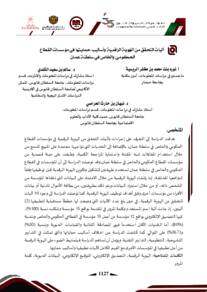وثيقة
واقع توظيف الهويّة الرقميّة وتحّدياتها في مؤسسات القطاع الحكومي والخاص في سلطنة ُعمان.
المصدر
رسالة ماجستير
عناوين أخرى
The Reality of Digital Identity Employment and Challenges in Government and Private Sector Institutions in the Sultanate of Oman
الدولة
عمان.
مكان النشر
مسقط
الناشر
جامعة السلطان قابوس
ميلادي
2024
اللغة
العربية
الموضوع
نوع الرسالة الجامعية
رسالة ماجستير
الملخص الإنجليزي
The study aimed to identify the motives for implementing digital identity in
public and private sector institutions in the Sultanate of Oman. It also explored the
procedures and mechanisms of digital identity verification, in addition to the
challenges facing its implementation in Omani institutions. The study relied on a
mixed method, using semi-structured interviews and a check list to collect data.
The study community is represented by government and private institutions
implementing digital identity in their work. The sample of the study included 15
institutions, of which 11 were from the government sector, and 4 were from the
private sector. The number of interviews was 21 interviews and 5 check list.
The study came up with a series of results, most notably the efforts of
government and private institutions in the Sultanate of Oman to implement digital
identity for many reasons, which varied from one institution to another as a result
of the different services provided and the objectives that seek to develop them
according to the strategies and executive plans of the institutions. However, despite
this difference, there is agreement on a set of motives represented by the following:
implementing the digital identity within the requirements of digital transformation
to achieve Oman Vision 2040, developing electronic services and ensuring the
quality of their delivery, reducing the proportion of fraud and impersonation,
ensuring high quality and accuracy of data, enhancing the process of strategic
planning and decision-making, and protecting the privacy of individuals.
The study revealed the procedures of identity implementation in public and
private sector organizations in Oman. These organizations use two methods, either
to create a digital identity by entering data manually, or by importing data in two
ways through a civil status card or through individual data from other institutions
based on the goals of implementing the digital identity. The total number of
mechanisms declared by the study sample in public and private sector institutions
reached 10 different methods, while the number of mechanisms for which future
have been developed for their implementations was 2 mechanisms. The mechanism
of username and password came at the forefront by 15 institutions (100%),
followed by the electronic certification mechanism by 12 institutions out of 15
institutions in the government and private sectors making (80%). The
implementation of electronic signatures and phone numbers was equal to 10
institutions making (18.9). The single-use mechanism ranked fifth in usage (53.3)
by 8 organizations. However, the least used techniques were the two-factor
authentication, biometric measurement by making (20% to 26.7%) respectively.
The study found that organizations are undergoing a range of regular legislation
and technical measures to protect digital identity.
The study results also revealed a set of challenges facing institutions in the
public and private sectors in the Sultanate of Oman in adopting and implementing
the digital identity including, the lack of awareness among individuals of the
importance of implementing digital identity, privacy concerns of users, weak
technical skills of employees in institutions, the weakness of the technical
infrastructure in the management of digital identity, the absence of user culture with
the mechanisms of activating digital identity, and the lack of financial allocations
in relation to the various aspects of the digital identity implementation.
The study concluded with a number of recommendations. The most
important of which is the development of a strategic plan for a unified digital
identity in all institutions of the Sultanate of Oman in both, public and private
sectors which can be done through cooperation with experts and technical
consultants in the Directorate of Digital Identity, monitored by the Royal Oman
Police and the Ministry of Transport, Communications, and Information
Technology. The study also recommended the need to hire experts in the analysis
of the data resulting from the implementation of digital identity and exploration
through the extraction of predictive patterns using the software implemented in
public and private sector institutions to serve the institution and the state as a whole
in analyzing and planning.
الملخص العربي
هدفت الدراسة إلى التعرف على دوافع توظيف الهوية الرقمية في مؤسسات القطاع الحكومي
والخاص في سلطنة عمان، وإجراءات وآليات التحقق من الهوية الرقمية، باإلضافة إلى التحديات التي تواجه
توظيفها في المؤسسات العمانية.
اعتمدت الدراسة على المنهج المدمج، واستخدمت المقابالت شبه المقننة واستمارة المراجعة الكمية
تمثل مجتم ُع والخاص ِة التي وظف ْت الهوية الرقمية في لجمع البيانات ، الدراس ِة من جميع المؤسسا ِت الحكومي ِة
بيئ ِة عملها، في حين شملت عينة الدراسة 15 مؤسسة، منها 11 مؤسسة من القطاع الحكومي، و 4 مؤسسات
من القطاع الخاص ، بلغ عدد المقابالت 21 مقابلة و 15 استمارة مراجعة.
توصلت الدراسة إلى مجموعة من النتائج أبرزها: سعي المؤسسات الحكومية والخاصة في سلطنة
ُعمان إلى توظيف الهوية الرقمية من أجل دوافع عديدة، تباينت من مؤسس ٍة إلى أخرى نتيجة اختالف الخدمات
ا لالستراتيجيات والخطط التنفيذية للمؤسسات، إال أن مع
التي تقدمها واألهداف التي تسعى إلى تطويرها وفقً
هذا التباين هنالك اتفاق حول مجموعة من الدوافع تمثلت في اآلتي: توظيف الهوية الرقمية ضمن متطلبات
التحول الرقمي تحقيقً 2040 و تطوير الخدمات اإللكترونية وضمان جود ة تقديمها و تقليل نسبة ا لرؤية عمان
التزوير واالنتحال و ضمان جودة ودقة البيانات بمستوى عال وتعزيز عملية التخطيط االستراتيجي وصنع
القرار وحماية خصوصية األفراد.
كشفت الدراسة عن طريقتين إلجراءات توظيف الهوية في مؤسسات القطاع الحكومي والخاص في
سلطنة عمان وهما: إنشاء هوية رقمية من خالل إدخال البيانات يدويًا، أو من خالل استيراد البيانات عن
طريق بطاقة األحوال المدنية أو بيانات األفراد من مؤسسات أخرى بناء على أهداف توظيف الهوية الرقمية،
أما آليات التحقق من الهوية الرقمية فقد بلغ إجمالي عدد اآلليات التي صرحت عنها أفراد عينة الدراسة في
مؤسسات القطاع الحكومي والخاص عشر طرق مختلفة، في حين بلغ عدد اآلليات التي وضعت لها خطط
مستقبلية لتطبيقها آليتين، إذ جاءت آلية اسم المستخدم وكلمة المرور في المقدمة بواقع 15 مؤسسة وشكلت
نسبة )%100(، تليها التصديق اإللكتروني بواقع 12 مؤسسة من أصل 15 مؤسسة في القطاعي الحكومي
VII
والخاص وبنسبة )80%(، في حين تساوى توظيف التوقيع اإللكتروني ورقم الهاتف بواقع 10 مؤسسات
وبنسبة )%18.9(، وجاءت آلية استخدام كلمة المرور للمرة الواحدة في المرتبة الخامسة في االستخدام بنسبة
)%53.3( بواقع 8 مؤسسات، أما التقنيات األقل استخدًما فهي المصادقة الثنائية والقياسات الحيوية وبنسبة
)%20( و)%26.7( على التوالي، وتوصلت الدراسة أن المؤسسات تتخذ مجموعة من التدابير التنظيمية
والتدابير التشريعية والتدابير التقنية لحماية الهوية الرقمية.
كما كشفت نتائج الدراسة مجموعة من التحديات التي تواجه المؤسسات في القطاع الحكومي
والخاص في سلطنة عمان في تبني وتوظيف الهوية الرقمية منها، تمثلت في غياب وعي األفراد بأهمية
توظيف الهوية الرقمية ومخاوف الخصوصية لدى المستخدمين و ضعف المهارات التقنية لدى العاملين
بالمؤسسات وضعف البنية التحتية التقنية في إدارة الهوية الرقمية وغياب ثقافة المستخدمين بآليات تفعيل
الهوية الرقمية وقلة المخصصات المالية المرتبطة بجوانب مختلفة في توظيف الهوية الرقمية.
وقد خلصت الدراسة إلى جملة من التوصيات من أهمها: وضع خطة استراتيجية من أجل توحيد
الهوية الرقمية في كافة مؤسسات سلطنة عمان في القطاع الحكومي والخاص؛ وذلك بالتعاون مع الخبراء
والمستشارين التقنين في نظم إدارة الهوية الرقمية، وتتولى متابعتها شرطة ُعمان السلطانية ووزارة النقل
والاتصالات وتقنية المعلومات ، كما أوصت الدراسة بضرورة توظيف خبراء في تحليل البيانات الناتجة من
توظيف الهوية الرقمية والتنقيب عنها، وذلك من خالل استخراج أنماط تنبؤية باستخدام البرمجيات الخاصة
بالتنقيب في مؤسسات القطاع الحكومي والخاص من أجل خدمة المؤسسة والدولة ككل في التحليل والتخطيط
والخاص في سلطنة عمان، وإجراءات وآليات التحقق من الهوية الرقمية، باإلضافة إلى التحديات التي تواجه
توظيفها في المؤسسات العمانية.
اعتمدت الدراسة على المنهج المدمج، واستخدمت المقابالت شبه المقننة واستمارة المراجعة الكمية
تمثل مجتم ُع والخاص ِة التي وظف ْت الهوية الرقمية في لجمع البيانات ، الدراس ِة من جميع المؤسسا ِت الحكومي ِة
بيئ ِة عملها، في حين شملت عينة الدراسة 15 مؤسسة، منها 11 مؤسسة من القطاع الحكومي، و 4 مؤسسات
من القطاع الخاص ، بلغ عدد المقابالت 21 مقابلة و 15 استمارة مراجعة.
توصلت الدراسة إلى مجموعة من النتائج أبرزها: سعي المؤسسات الحكومية والخاصة في سلطنة
ُعمان إلى توظيف الهوية الرقمية من أجل دوافع عديدة، تباينت من مؤسس ٍة إلى أخرى نتيجة اختالف الخدمات
ا لالستراتيجيات والخطط التنفيذية للمؤسسات، إال أن مع
التي تقدمها واألهداف التي تسعى إلى تطويرها وفقً
هذا التباين هنالك اتفاق حول مجموعة من الدوافع تمثلت في اآلتي: توظيف الهوية الرقمية ضمن متطلبات
التحول الرقمي تحقيقً 2040 و تطوير الخدمات اإللكترونية وضمان جود ة تقديمها و تقليل نسبة ا لرؤية عمان
التزوير واالنتحال و ضمان جودة ودقة البيانات بمستوى عال وتعزيز عملية التخطيط االستراتيجي وصنع
القرار وحماية خصوصية األفراد.
كشفت الدراسة عن طريقتين إلجراءات توظيف الهوية في مؤسسات القطاع الحكومي والخاص في
سلطنة عمان وهما: إنشاء هوية رقمية من خالل إدخال البيانات يدويًا، أو من خالل استيراد البيانات عن
طريق بطاقة األحوال المدنية أو بيانات األفراد من مؤسسات أخرى بناء على أهداف توظيف الهوية الرقمية،
أما آليات التحقق من الهوية الرقمية فقد بلغ إجمالي عدد اآلليات التي صرحت عنها أفراد عينة الدراسة في
مؤسسات القطاع الحكومي والخاص عشر طرق مختلفة، في حين بلغ عدد اآلليات التي وضعت لها خطط
مستقبلية لتطبيقها آليتين، إذ جاءت آلية اسم المستخدم وكلمة المرور في المقدمة بواقع 15 مؤسسة وشكلت
نسبة )%100(، تليها التصديق اإللكتروني بواقع 12 مؤسسة من أصل 15 مؤسسة في القطاعي الحكومي
VII
والخاص وبنسبة )80%(، في حين تساوى توظيف التوقيع اإللكتروني ورقم الهاتف بواقع 10 مؤسسات
وبنسبة )%18.9(، وجاءت آلية استخدام كلمة المرور للمرة الواحدة في المرتبة الخامسة في االستخدام بنسبة
)%53.3( بواقع 8 مؤسسات، أما التقنيات األقل استخدًما فهي المصادقة الثنائية والقياسات الحيوية وبنسبة
)%20( و)%26.7( على التوالي، وتوصلت الدراسة أن المؤسسات تتخذ مجموعة من التدابير التنظيمية
والتدابير التشريعية والتدابير التقنية لحماية الهوية الرقمية.
كما كشفت نتائج الدراسة مجموعة من التحديات التي تواجه المؤسسات في القطاع الحكومي
والخاص في سلطنة عمان في تبني وتوظيف الهوية الرقمية منها، تمثلت في غياب وعي األفراد بأهمية
توظيف الهوية الرقمية ومخاوف الخصوصية لدى المستخدمين و ضعف المهارات التقنية لدى العاملين
بالمؤسسات وضعف البنية التحتية التقنية في إدارة الهوية الرقمية وغياب ثقافة المستخدمين بآليات تفعيل
الهوية الرقمية وقلة المخصصات المالية المرتبطة بجوانب مختلفة في توظيف الهوية الرقمية.
وقد خلصت الدراسة إلى جملة من التوصيات من أهمها: وضع خطة استراتيجية من أجل توحيد
الهوية الرقمية في كافة مؤسسات سلطنة عمان في القطاع الحكومي والخاص؛ وذلك بالتعاون مع الخبراء
والمستشارين التقنين في نظم إدارة الهوية الرقمية، وتتولى متابعتها شرطة ُعمان السلطانية ووزارة النقل
والاتصالات وتقنية المعلومات ، كما أوصت الدراسة بضرورة توظيف خبراء في تحليل البيانات الناتجة من
توظيف الهوية الرقمية والتنقيب عنها، وذلك من خالل استخراج أنماط تنبؤية باستخدام البرمجيات الخاصة
بالتنقيب في مؤسسات القطاع الحكومي والخاص من أجل خدمة المؤسسة والدولة ككل في التحليل والتخطيط
قالب العنصر
الرسائل والأطروحات الجامعية


